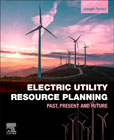
Electric utilities are moving to adopt greater levels of renewable power, for reasons that environmental stewardship and cost savings. While not every utility envisions 100% renewables, the trend is for them to all move towards that goal, some faster than others. Electric Utility Resource Planning emphasizes the route to total adoption as an intricate balance of renewable cost, energy storage, and flexible backstop mechanisms, with optimization of planning methodologies and market design. It argues that net load, ramping and volatility concerns associated with renewables call into question the validity of almost a century of planning approaches. It suggests that accounting for flexibility helps optimize the efficiency of the entire fleet of assets, minimizing costs and CO2 generation simultaneously, concluding that a flexible backstop mechanism is needed independently of renewables or storage. It describes how meeting the revenue requirements for any generator, and especially for energy storage assets, will require consideration of ancillary service and real-time energy revenues, and shows how those markets are evolving to stimulate the adoption of flexible capacity by utilities. Case studies provide a mix of hypothetical what if scenarios and analyses of real-life utility portfolios drawn from international examples Examines how resource planners and policy specialists can plan to incorporate renewable generation technologies, uniting consideration of technology, methodology, business and policyFocuses on the reality of long-term decision-making and planning processes in working utilitiesReviews novel approaches towards resource planning that yield lower costs and CO2Emphasizes the need for flexible backstop mechanisms to maintain reliability INDICE: 1. The way things used to be 2. Influx of renewables, the way things are going 3. Long Term Capacity Expansion Planning 4. Impact of Accounting for Flexibility (or lack thereof) 5. Towards 100% renewables 6. Market design considerations 7. Conclusion Appendix 1: Generation Technology Parameters for Planners
- ISBN: 978-0-12-819873-5
- Editorial: Elsevier
- Encuadernacion: Rústica
- Páginas: 304
- Fecha Publicación: 01/11/2020
- Nº Volúmenes: 1
- Idioma: Inglés
